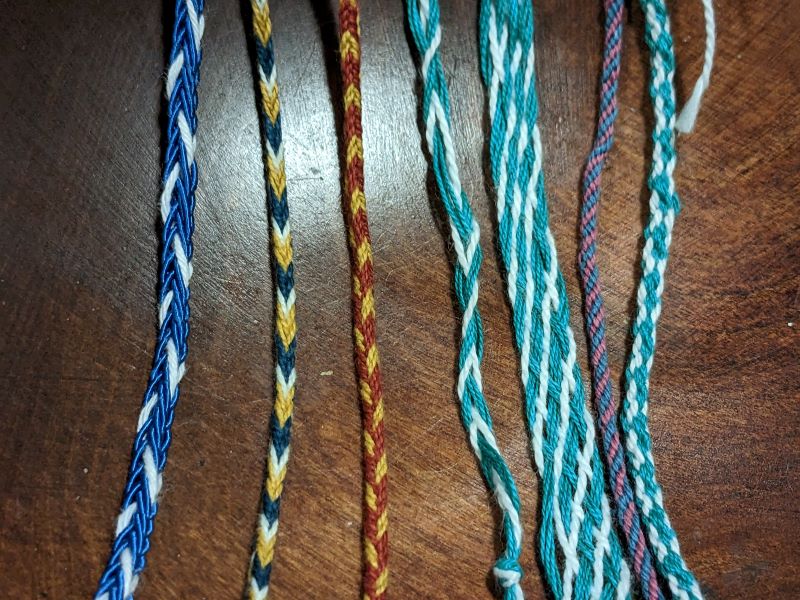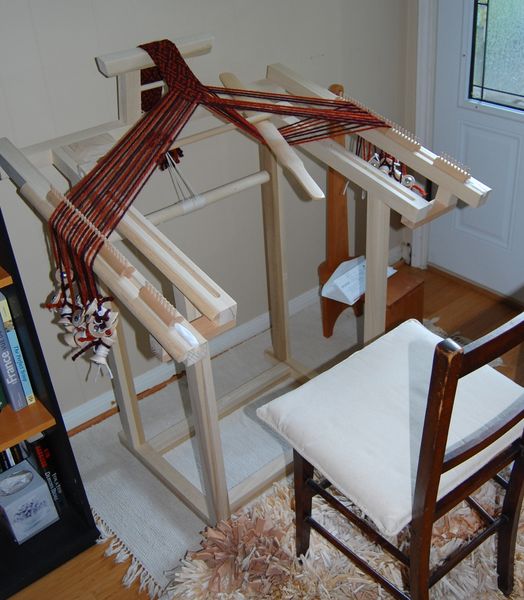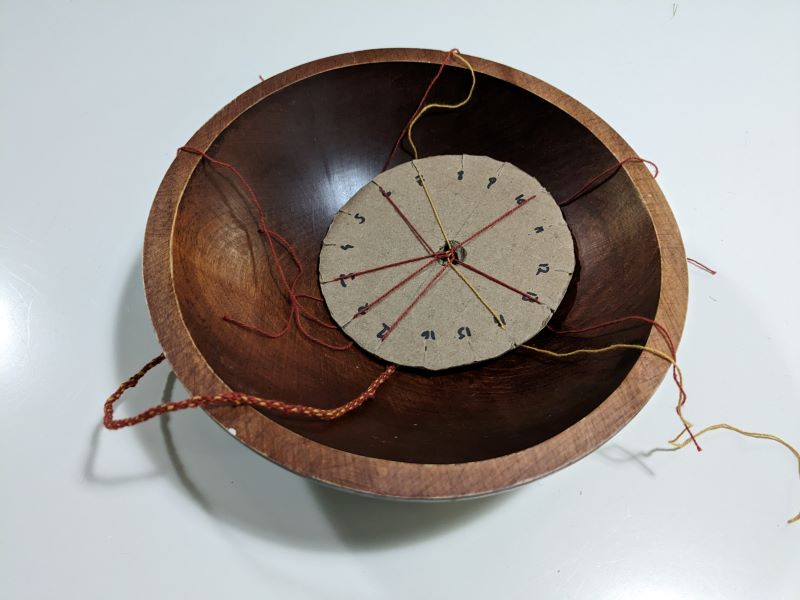What’s the difference between braiding and weaving?
other fiber artsterminologyI was traveling last week, and decided it was a good time to take a look at braiding since I couldn't bring my loom! I’d picked up an old book on braiding a couple months ago at a guild giveaway, “The Basic Book of Fingerweaving” by Esther Warner Dendel, and I hadn’t had a chance to really look at it. So I packed up some scrap yarns, made myself a kumihimo disk out of scrap cardboard, and have been playing with braids! Which leaves me thinking about how these two crafts differ.

Braiding (or plaiting) and weaving are both ways of making textiles by interlacing yarn in an over/under pattern (and a wide range of variations!). We’re all familiar with the basic 3 strand braid but there’s a huge range of techniques that fall under braiding - kumihimo, fingerloop braiding, fingerweaving, ply-split braiding, bobbin lace, and more.
Many braiding techniques don’t need any tools but there’s a wide range of ways to manage longer and more complex braids, like bobbins and frames like the marudai and takudai used in traditional kumihimo.

Braiding and weaving are more similar to each other than they are to knitting or crochet, which work with loops of yarn, or techniques based around knots, like macramé. They are also both related to basketry techniques that work with stiffer materials; braiding, weaving, and basketry are all ancient and go back to the stone age, with braiding and basketry likely being older than weaving. And of course to add to the confusion the actions used in braiding are sometimes referred to as weaving, and braiding is sometimes referred to as a kind of “off loom weaving”.
And ‘Fingerweaving’? It’s a term sometimes used to describe making braided textiles (as opposed to hairstyling) in general, as in the vintage book I picked up, but more often it refers to a specific technique for making flat braids that originated with indigenous peoples in the Americas.
The following are the main ways braiding and weaving are different:
- Weaving has a distinct warp (lengthwise) and weft (widthwise) yarns, while in braiding all yarns are used similarly (and often referred to as strands). This allows for weaving to use heddles to raise groups of warp threads to speed up the process.
- In weaving the interlacements are based on 90 degree angles, while braiding uses "oblique" angles (aka not 90 degrees).
- Braiding requires that one end of the strands can be manipulated. In weaving both ends of the warp are fixed to some kind of loom and only the weft is freely manipulated. If it seems more like braiding but both ends are fixed, it might be sprang.
- Braiding is worked with the braid forming at the “far” end and coming closer, as it’s the loose ends being manipulated, while weaving is the opposite, as the weft is usually pressed into place towards the weaver.
- Braiding can use as few as 3 yarns for the basic braid that most people know how to do. While you can sort of weave with just 2 warp and a weft, it’s not very stable and the smallest weaving pattern I’ve come across is shoelaces with 9 warp + a weft.
- The exact number of yarns used has more influence on difficulty, patterns, and techniques in braiding than in weaving. Some braiding techniques work with specific numbers of strands, or must have an even or odd number, and adding a single strand might dramatically change the pattern rather than make a stripe wider. 20 strands is a complex braid but a small narrow weave.
- Weaving most often makes flat fabric, and can make tubes or have slits. Braids can be flat, round, square, tubular, and more; and they can split apart and join together again or form zig zag shapes. Bobbin lace is an elaborate braiding technique to make intricate laces. While both braiding and weaving can produce flat structures, braids are usually much narrower, though they can be joined to make larger pieces.
- Braids can make a very strong rope or cord that holds up well under tension, but is often not as strong widthwise or when it’s compressed; weaving is about equally strong in both warp and weft directions.
There’s a wide range of techniques for both weaving and braiding, and not every point applies to every technique, but you’ll find that all but a couple of them will be on one side or the other! Most definitions focus on the distinct warp and weft and 90 degree interlacements, but there are some circumstances where those don’t quite work, like continuous strand or circular weaving.
This past week I’ve played around with a few techniques to make flat braids from the book as well as 8 strand round kumihimo and 5 loop square fingerloop braids (which have 10 strands). I’ve found the kumihimo and fingerloop quite easy to get the hang of with the odd error, while I found some of the flat braid techniques like “Peruvian Flat Braid” easier to lose my place in and keep tight! Kumihimo on a disk is particularly handy for being very easy to put down and pick up again later.

If you want to play around with braiding as a weaver, your thrums make great material to practice with! You can combine braiding with weaving by braiding your fringes, using braids to make a cord for a bag or trim for a pillow, braiding hang loops for towels, and I’m sure many other things!
Here are some resources on different kinds of braiding:
The Braid Society - Begin Braiding - Covers a range of different styles.
Kumihimo Tutorial - a simple tutorial video to get you started on 8 strand round braids with a DIY cardboard Kumihimo disk.
LoopBraider.com - 5-loop square and flat braids - This site has a ton of resources on all things fingerloop braiding.
Fingerloop braid for fringe - this video shows how to braid your fringe using fingerloop braids.
Check out Not So Rigid Designer, the online weaving software for rigid heddle loom weavers!
